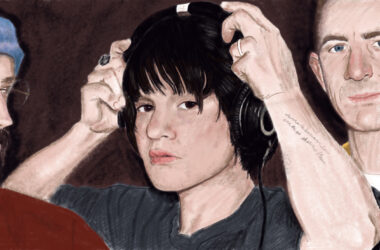The soft-spoken, good-humored voice on the phone line clashed with what I had been listening to only moments before: Heavy drum beats, rolling bass, guitar riffs, and resonant Inuit throat singing. All of these feature on Nicolas Pirti-Duplessis otherwise known as Arctistic’s new album, Anirniq. Slightly over 40 minutes long, the 12-track musical endeavour combines elements from both conventional rock and roll and traditional Inuit sounds while simultaneously diving deeper into themes, such as Indigenous languages and Inuit mythology, close to Arctistic’s heart.
The album title Anirniq means “spirit” or “breath of life” in Inuktitut, a theme Artistic incorporates throughout. The album focuses on five overarching themes: Environment and climate change, residential schools and cultural suppression, the mental health crisis in Inuit communities, Inuit mythology and religious beliefs, and Indigenous languages in present-day Canada. Pieces such as Brother focus on the horrors of residential schools by taking the viewpoint of a survivor, while others, like the title track Sealskin Cowboy, are based on Inuit traditional life.
In an interview with The Tribune, Artistic explained how Sealskin Cowboy is based on the traditional Inuit hunter as he tries to provide for his family amidst famine. The song brings the hunter back to life, reflecting the meaning of the album title and showing how he triumphs over this food insecurity crisis.
“This album is unique because we were focusing a lot on conventional sounds while also trying something new [compared to the last album] like Inuit throat singing. These are done by Inuit women [such as Evie Mark]—there’s one that leads and another one follows. [They are] imitating sounds, animals, [or the] environment,” Artistic said.
He described how this album was a big jump from previous solo work, in which he focused on his sole creative vision. However in Anirniq, six people, both singers and producers, collaborated on the music-making process.
“I come from a community, Nunavik where the people are from other regions; they are all the same culture but the dialect and language are […] different. [F]rom Alaska to Greenland, we’re basically the same people with minor differences. Canada, we are only 6[5],000 Inuit, and where I come from in Nunavik, it’s only 14,000 Inuit. It’s a small population so it’s quite challenging to find other [artists] you can collaborate with so I was really lucky to find them here in Montreal,” he shared.
Family and community play a large role in Arctistic’s work. He explained that he was inspired by his father’s love of the guitar and artists such as The Beatles and The Rolling Stones to first get involved with music at age 14. The cover art for Anirniq also has deep familial ties to his grandfather, Levi Alasua Pirti from Smith Island, who was a sculptor. After finding one of his works on an eBay auction, Arctistic knew it would be the cover art for the project. The artist remarked how it was such a funny coincidence he found the sculpture at that time, especially because it was originally created to represent the idea of spirit.
“My method in songwriting is always sound comes first and then I come up with the subject. The lyrics are always at the end of the procedure. That’s where I think about a subject […] such as culture or language,” Artistic said.
His thoughtfulness and care are reflected in the lyrics and the delicate yet powerful way he tackles the subjects he focuses on. The conventional rock and roll sounds add intensity and strength to the rhythm of the lyrics which alternate between chantlike and melodic, sometimes within the same song. With its head-nodding and sometimes head-banging catchiness, this album will be instantly added to any summer playlist.
Arctistic’s album Anirniq is available to stream on Spotify, YouTube Music, Apple Music, and Bandcamp as well as all other music platforms.







